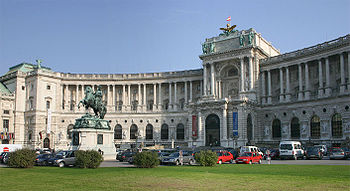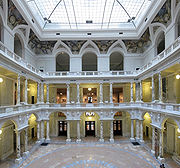
Vienna Museum of Ethnology
Encyclopedia


Vienna
Vienna is the capital and largest city of the Republic of Austria and one of the nine states of Austria. Vienna is Austria's primary city, with a population of about 1.723 million , and is by far the largest city in Austria, as well as its cultural, economic, and political centre...
is the largest anthropological museum in Austria, established in 1876. It currently resides in the Hofburg Imperial Palace
Hofburg Imperial Palace
Hofburg Palace is a palace located in Vienna, Austria, that has housed some of the most powerful people in Austrian history, including the Habsburg dynasty, rulers of the Austro-Hungarian empire. It currently serves as the official residence of the President of Austria...
and houses a quarter million ethnographical and archaeological objects from Asia, Africa, Oceania, and America. Important collections include Mexican artifacts, with unique Aztec
Aztec
The Aztec people were certain ethnic groups of central Mexico, particularly those groups who spoke the Nahuatl language and who dominated large parts of Mesoamerica in the 14th, 15th and 16th centuries, a period referred to as the late post-classic period in Mesoamerican chronology.Aztec is the...
featherwork
Featherwork
Featherwork is the working of feathers into a cultural artifact. This was especially elaborate among the peoples of Oceania and the Americas, such as the Incas and Aztecs....
; part of James Cook
James Cook
Captain James Cook, FRS, RN was a British explorer, navigator and cartographer who ultimately rose to the rank of captain in the Royal Navy...
's collection of Polynesia
Polynesia
Polynesia is a subregion of Oceania, made up of over 1,000 islands scattered over the central and southern Pacific Ocean. The indigenous people who inhabit the islands of Polynesia are termed Polynesians and they share many similar traits including language, culture and beliefs...
and Northwest Coast art
Northwest Coast art
Northwest Coast art is the term commonly applied to a style of art created primarily by artists from Tlingit, Haida, Tsimshian, Kwakwaka'wakw, Nuu-chah-nulth and other First Nations and Native American tribes of the Northwest Coast of North America, from pre-European-contact times up to the...
(purchased in 1806); numerous Benin bronzes
Benin Bronzes
The Benin Bronzes are a collection of more than 3000 brass plaques from the royal palace of the Kingdom of Benin . They were seized by a British force in the Punitive Expedition of 1897 and given to the British Foreign Office...
; the collection of Charles von Hügel
Charles von Hügel
Charles von Hügel was an Austrian army officer, diplomat, botanist and explorer, now primarily remembered for his travels in northern India during the 1830s...
from India, Southeast Asia, and China; the contents of a museum created to house the collections form the Austrian Brazil Expedition
Austrian Brazil Expedition
The Austrian Expedition to Brazil was a great expedition of scientific inquiry which explored Brazil, with prominence in the areas of Botany, Zoology and Ethnography...
; artifacts collected during the circumnavigation of the globe by the SMS Novara
SMS Novara (1850)
SMS Novara was a sail frigate of the Austro-Hungarian Navy most noted for sailing the globe for the Novara Expedition of 1857–1859 and, later for carrying Archduke Maximilian and wife Carlota to Vera Cruz in May 1864 to become Emperor and Empress of Mexico.-Service :The SMS Novara was a frigate...
; and two of the remaining rongorongo
Rongorongo
Rongorongo is a system of glyphs discovered in the 19th century on Easter Island that appears to be writing or proto-writing. It cannot be read despite numerous attempts at decipherment. Although some calendrical and what might prove to be genealogical information has been identified, not even...
tablets.
The museum's most famous piece is a feathered headdress
Montezuma's headdress
Moctezuma's headdress is a featherwork crown which tradition holds belonged to Moctezuma II, the Aztec emperor at the time of the Spanish Conquest. However, its provenance is uncertain, and even its identity as a headdress has been questioned. It is made of quetzal and other feathers mounted in a...
believed to have belonged to Moctezuma
Moctezuma II
Moctezuma , also known by a number of variant spellings including Montezuma, Moteuczoma, Motecuhzoma and referred to in full by early Nahuatl texts as Motecuhzoma Xocoyotzin, was the ninth tlatoani or ruler of Tenochtitlan, reigning from 1502 to 1520...
, the last Aztec emperor, which has created friction between the Mexican and the Austrian governments. Although taken from Mexico as war booty by the Spanish in the 16th century, Austria acquired it legally from France in 1880.
The Museum of Ethnology is not to be confused with the Austrian Folklore Museum, (the Österreichisches Museum für Volkskunde), which has a similar name in German but concentrates on European artifacts.
External links
- Museum website in English

